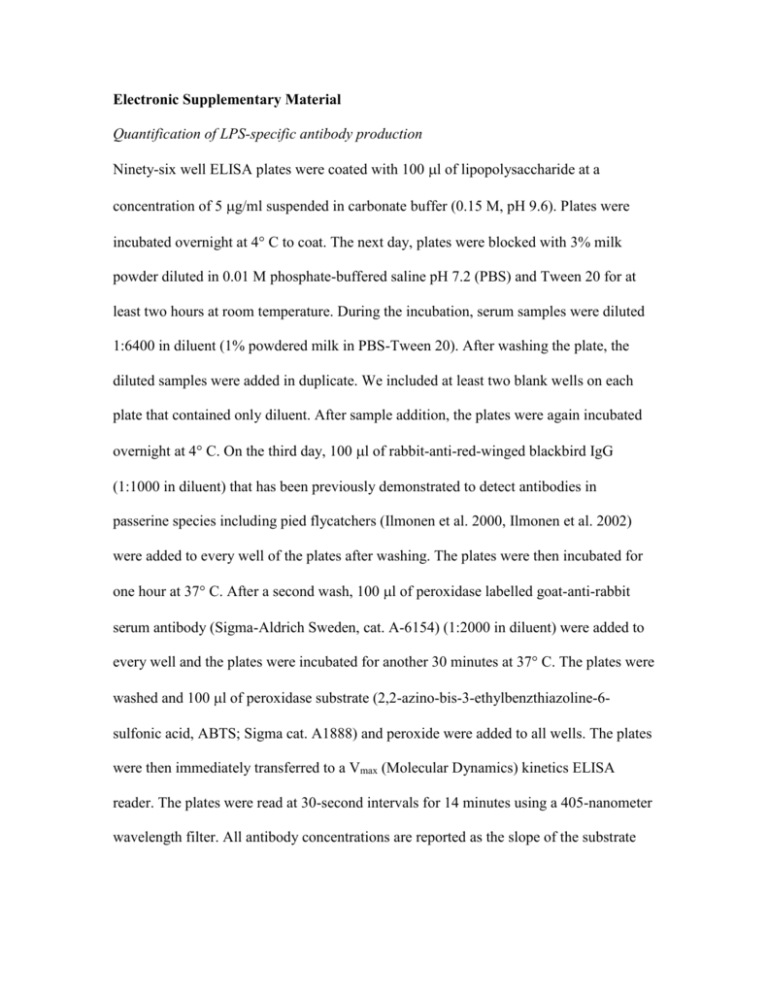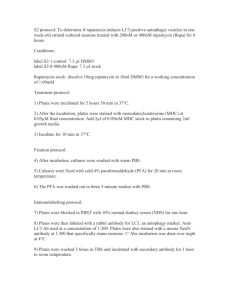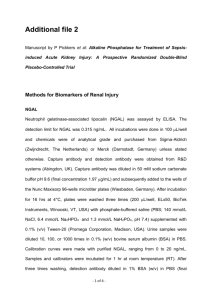Electronic Supplementary Material
advertisement

Electronic Supplementary Material Quantification of LPS-specific antibody production Ninety-six well ELISA plates were coated with 100 l of lipopolysaccharide at a concentration of 5 g/ml suspended in carbonate buffer (0.15 M, pH 9.6). Plates were incubated overnight at 4° C to coat. The next day, plates were blocked with 3% milk powder diluted in 0.01 M phosphate-buffered saline pH 7.2 (PBS) and Tween 20 for at least two hours at room temperature. During the incubation, serum samples were diluted 1:6400 in diluent (1% powdered milk in PBS-Tween 20). After washing the plate, the diluted samples were added in duplicate. We included at least two blank wells on each plate that contained only diluent. After sample addition, the plates were again incubated overnight at 4° C. On the third day, 100 l of rabbit-anti-red-winged blackbird IgG (1:1000 in diluent) that has been previously demonstrated to detect antibodies in passerine species including pied flycatchers (Ilmonen et al. 2000, Ilmonen et al. 2002) were added to every well of the plates after washing. The plates were then incubated for one hour at 37° C. After a second wash, 100 l of peroxidase labelled goat-anti-rabbit serum antibody (Sigma-Aldrich Sweden, cat. A-6154) (1:2000 in diluent) were added to every well and the plates were incubated for another 30 minutes at 37° C. The plates were washed and 100 l of peroxidase substrate (2,2-azino-bis-3-ethylbenzthiazoline-6sulfonic acid, ABTS; Sigma cat. A1888) and peroxide were added to all wells. The plates were then immediately transferred to a Vmax (Molecular Dynamics) kinetics ELISA reader. The plates were read at 30-second intervals for 14 minutes using a 405-nanometer wavelength filter. All antibody concentrations are reported as the slope of the substrate conversion (in 10-3 x optical densities (OD); mOD) over time (mODmin-1), with a higher slope indicating a higher concentration of antigen-specific antibodies in a sample. We calculated the mean of the duplicate values for each sample to compute antibody titre. Also the mean value of the blanks was subtracted from the measured antibody titter to account for non-specific binding. On each plate, we included a dilution series of a standard pool that covered the range of antibody titres for female and offspring samples. We used the differences between the standard curves to account for between-plate variation. Quantification of total antibody levels ELISA plates were coated with 100 l of anti-chicken IgG (donkey anti-chicken IgG, ICN Biomedicals, Cat. No. 67-645) at a concentration of 6 g/ml suspended in carbonate buffer (0.15 M, pH 9.6) (Grindstaff et al. 2005). Plates were incubated overnight at 4° C to coat. The next day, plates were blocked with 3% milk powder diluted in PBS-Tween 20 for at least two hours at room temperature. During the incubation, serum samples from females and offspring were diluted 1:200 in diluent (1% milk powder, PBS-Tween 20). After washing, diluted serum samples were added to the plate in duplicate. We also included at least two blank wells (containing only diluent) on each plate. The plates were again incubated overnight at 4° C. Methods on the third day and for computation of antibody titres are the same as those described above for quantifying LPS-specific antibodies. References Grindstaff, J.L., Demas, G.E. & Ketterson, E.D. 2005 Diet quality affects egg size and number but does not reduce maternal antibody transmission in Japanese quail Coturnix japonica. Journal of Animal Ecology 74, 1051-1058. Ilmonen, P., Taarna, T. & Hasselquist, D. 2000 Experimentally activated immune defence in female pied flycatchers results in reduced breeding success. Proceedings of the Royal Society of London, Series B 267, 665-670. Ilmonen, P., Taarna, T. & Hasselquist, D. 2002 Are incubation costs in female pied flycatchers expressed in humoral immune responsiveness or breeding success? Oecologia 130, 199-204.









